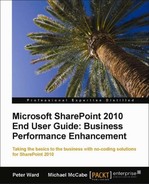You can think of Backstage as a vastly expanded File menu. In Office 2003 and earlier, you will recall the main menu with File, Edit, Insert, and so on. With Office 2007 and the introduction of the Ribbon, most of the functionality from the old File menu was accessed by clicking the Office logo in the upper left-hand corner of the screen. With Office 2010, you will find the functionality by clicking the first tab, appropriately named File.
Tip
In Office 2007, the Office Logo icon that appeared above the Ribbon is referred to as the Office Pearl. Similarly, in Windows 7, the Windows Logo that replaced the word Start on the toolbar is referred to as the Windows Pearl.
To view Backstage in all Office 2010 applications, click on the File tab. This opens Backstage, and you quickly realize it has gone beyond what was available in the earlier File menu.
In this view, you can see the full range of information about the document, including authors' profiles, metadata, and workflows. Most of the information is stored with the document in SharePoint. Backstage makes it easier to access because you can see it in Word, for example, without having to switch between the application and SharePoint.
It is like having a window right into SharePoint. Not only is the information accessible, but you can interact with it, making it easier to get your work done faster.
The Backstage view can also be extended; that is, you can add custom actions to meet specific business requirements, though this requires custom code and is outside the scope of our discussion in this book.
In Office 2010, the File menu has been expanded to include a range of options for printing, saving, sharing, and controlling a document.
Commands familiar from earlier versions of the File menu can be found here, such as Save, Open, Close, and Exit. With Office 2010, choices such as Info, Print, and Save & Send expand what you can do with a document from this one location, especially when working with a document stored in SharePoint.
Note
Backstage's tabbed design gives an easier way of managing all the expanded functionality that has become available with Office 2010 and the deeper integration with SharePoint Server 2010.
Let's take a closer look at the Info and Save & Send sections.
In this section, you can check documents in and out of SharePoint.
Note
The Info section in Backstage is only available for documents stored on SharePoint 2010 servers.
You can leave notes for others on the Note Board.

This note will also appear in an information bar just below the Ribbon and above the document:

The Note will also appear on the author's My Site on the Note Board, under Tags and Notes:

Permissions allow you to restrict access to a document and to encrypt documents with a password. You can also restrict what a user can do with the document, such as print, copy, or edit.
You can control the permissions to the document by clicking on Protect Document.

In SharePoint 2007, managing permissions could only be done in a SharePoint library. Now, it can be done right from the application where the document is edited.
You can prepare the document for sharing by deleting personal information or slide notes; to do this, click on Check for Issues.
The Info section of Backstage is also where you can control the versions of the document stored on SharePoint by clicking on Manage Versions.
This section is the most important for working on documents stored on SharePoint and collaborating with others.
Backstage Save & Send allows you to:
- Save and Send
- Send Using e-mail
Note
With this choice, you can attach the document in an e-mail message, or send a link to where the document is stored on SharePoint.
- Save to Web
- Save to SharePoint
- Publish as Blog Post
- Manage File Types
- Change File Type to an earlier version of Word, for example, or to a format used in other applications
- Create PDF/XPS Document
- Manage Workflows
When workflows are available in the SharePoint document library, where the document being edited resides, they will be available here. You can start a workflow here, or if one is already in progress you can check its status.

Publishing blogs is one of the new Social Computing features of SharePoint 2010. Blogging and tagging are what are often referred to as Web 2.0 features. We will discuss more about these capabilities in Chapter 12, Blogs, Wikis, and Other Web 2.0 Features, but here we can see how Backstage facilitates blogging.
This option, within the Save & Send section of Backstage, makes it easy for you to author blog contributions in Word and then publish them to the web. To publish a blog from Word 2010 directly to a SharePoint site, follow these steps:
- Create your blog in Word 2010.
- Click on the File tab to open Backstage.
- Click on Save & Send.
- Click on Publish as Blog Post, and Word 2010 will convert the document to a blog.
- On the Ribbon, click on Publish.

- Enter the URL where your Blog is located (usually on your SharePoint My Site) and it will be published:

In this section, we have seen how Backstage provides a point of central control over the various ways an Office document can interact with SharePoint. From Backstage you can view information about your document, whether that information is stored in the document itself or on SharePoint. You can save your document to SharePoint, as well as publish it as a blog on a SharePoint site. Backstage allows you to interact with SharePoint without having to leave the application. You stay where you can work on your content without having to jump back-and-forth to a browser in order to access SharePoint functionality.
